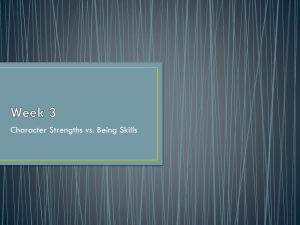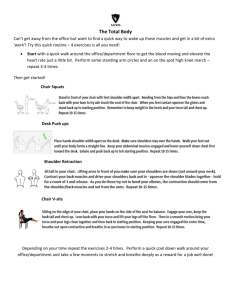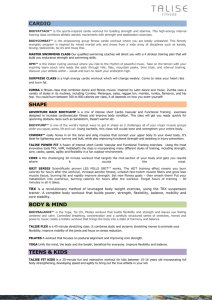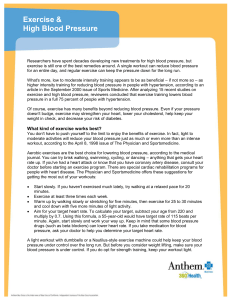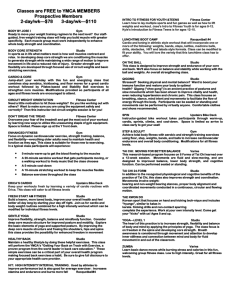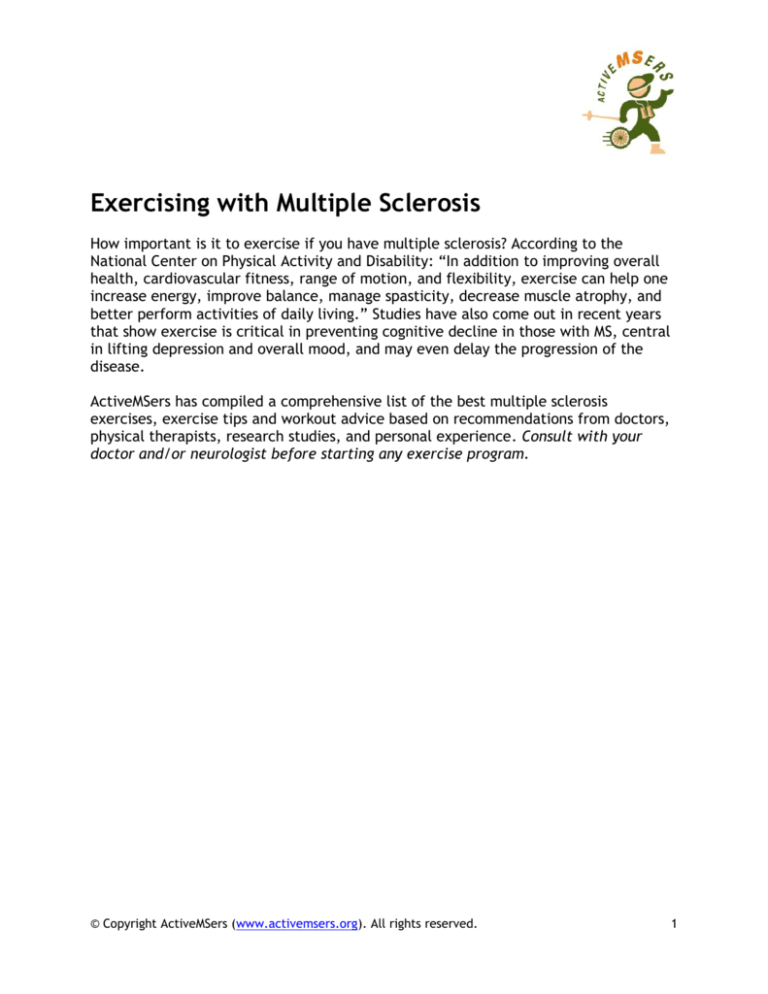
Exercising with Multiple Sclerosis
How important is it to exercise if you have multiple sclerosis? According to the
National Center on Physical Activity and Disability: “In addition to improving overall
health, cardiovascular fitness, range of motion, and flexibility, exercise can help one
increase energy, improve balance, manage spasticity, decrease muscle atrophy, and
better perform activities of daily living.” Studies have also come out in recent years
that show exercise is critical in preventing cognitive decline in those with MS, central
in lifting depression and overall mood, and may even delay the progression of the
disease.
ActiveMSers has compiled a comprehensive list of the best multiple sclerosis
exercises, exercise tips and workout advice based on recommendations from doctors,
physical therapists, research studies, and personal experience. Consult with your
doctor and/or neurologist before starting any exercise program.
© Copyright ActiveMSers (www.activemsers.org). All rights reserved.
1
Top 6 Tips
1) Stretch daily. Flexibility exercises—muscle stretching and range of motion
exercises (ROM)—can help prevent shrinkage or shortening of muscles and can
help reduce the severity of spasticity symptoms. Dedicate at least 10-15
minutes of stretching every day, ideally several times a day.
2) Experiment. MS affects everyone differently, so try different ways of
exercising to see what works best for you. Swimming and walking are popular,
as are horseback riding and biking (try a three-wheeled trike if balance is an
issue). Give a go at yoga, tai chi, or Pilates, or even an exercise class for
seniors. Work out to videos at home or circuit train at the gym. Adaptive ski
programs can be a great way to enjoy the cool outdoors.
3) Stay cool. Heat, while it won’t trigger an attack, can exacerbate your MS
symptoms, which can range from annoying to debilitating. Go to the gym when
it’s cool, exercise in the morning, seek out air conditioning, consider snow
sports, and put swimming (regardless of how you look in bathing suit) on your
list. Use gear like cooling vests and cold packs, and don’t forget to down icy
drinks to keep your core temperature from rising too much.
4) Cardio is key. MS research continues to support the importance of cardio
workouts. Not only does it improve fatigue and overall quality of life, but also
raising your heart rate appears to influence the progression disease, decreasing
both damage to the brain (fewer lesions) and brain atrophy. And yes, even if
you are in a wheelchair, you likely can still do seated aerobic workouts.
5) Train in bursts. Fatigue or weakness can come on quickly, especially when
doing the recommended cardio. Space out your “hard” exercise with frequent
breaks if needed. High intensity interval training (or HIIT), where you sprint
then rest then sprint then rest can be quite effective. Mini workouts all
combined produce the same or even better benefits as one long one.
6) Remember, MS is BS: multiple sclerosis is beatable someday. Optimism when
fighting an incurable disease is essential to good mental health. You want to be
ready when that cure comes—and I am confident it will in our lifetimes—with
the healthiest body and mind possible. You can do this. You can definitely do
this.
© Copyright ActiveMSers (www.activemsers.org). All rights reserved.
2
Prep Work
Start slowly. Nothing crashes a multiple sclerosis exercise program like going out full
guns and wiping yourself out for a week. Easy does it, even if it means just a few
minutes a day. Patience is key. Gains will come. A fellow MSer wrote me about going
from 5 minutes of exercise a day to 50 minutes a day!
Listen to your body. With MS, it is easy to go over that fatigue edge. How can you
tell if you’ve overdone it? If you still feel ucky and tired two or three days after your
exercise, bingo, you’ve worked out too hard and need to dial it back.
Wear the proper shoes. If stability is an issue, you’ll want a tennis shoe that will
maximize balance. If you are running, see a professional at a specialty running store
to get the right shoe for you. Just walking? Still go to a running store. Running shoes
are constructed far better than your budget walking shoe.
Let your clothes breathe. Synthetic performance clothing wicks moisture and keeps
you dry. Traditional cotton breathes well and can help you stay cooler while you
exercise. The benefit of synthetics is maximized if you are participating in outdoor
sports where the breeze becomes your best friend (and potential enemy if you are
wet).
Invest in a pedometer. Researchers have found that people walk more in a day if
they are keeping track of the number of steps they take. Unless you are in a
wheelchair, this is a great way to build up your exercise, even if you never leave the
house. Those little walks from the couch to the kitchen can add up! I recommend the
activity meters at Fitbit, which record how active you are every day and upload it
automatically to your computer.
Get the right adaptive gear. If you have foot drop, where your foot slaps the
pavement and you scuff or stub that toe, consider investing in an ankle foot orthosis
(AFO); the Toe Off by Allard is highly recommended by members. The WalkAide and
Bioness also ward off foot drop effectively.
Stay close to home. The closer the gym is to your house, the more likely you are to
go to the gym. That also means less driving, fewer minutes out of your day wasted,
and less stress worrying about fitting in a workout. Also look for a fitness center with
a pool, an essential extra for MSers. And having a convenient bathroom not located
500 yards from the stretching mats is always a plus.
© Copyright ActiveMSers (www.activemsers.org). All rights reserved.
3
Consult a pro. Your health insurance will likely cover the initial cost of you seeing a
physical therapist, who can customize an exercise program to your abilities and show
you proper ways to stretch and workout. When you go to the appointment, be
prepared with a succinct medical history, changes in the last three months (are you in
a flare?), personal goals (climb stairs, stand to cook dinner, etc.), current issues,
recent falls (how many, how did it happen?), and list of questions. Be honest with
your PTs and for gosh sakes listen to them. If they say “use a cane” then do it.
Research local MS programs. There are multiple sclerosis societies worldwide and
many of them offer exercise programs and classes geared to those with MS. Give them
a try; you might meet some great new friends and get fit to boot. It’s also nice to
know everyone is in the same boat trying to paddle.
Alternate strength training. To keep fresh, try not to strength train the same set of
muscles on back-to-back days (although abs are usually okay). I switch off between
arms and legs. If an area still feels fatigued a couple days after exercising, give it an
extra day or two.
Remember the meds. You might need to work your exercise program around your
medications. Interferons, for example, can make some folks feel icky the next day.
Plan around your icky times—don’t just plow through them.
Sometimes dial it back. If you are battling a relapse, take it easy on the exercise
front. Yes, you can still exercise, but be smart about it. Ratchet back the intensity
and focus on maintaining fitness rather than building. Slowly work your way back up.
© Copyright ActiveMSers (www.activemsers.org). All rights reserved.
4
At Home
Lie down in front of the TV. Seriously, roll out a yoga mat and get to work on the
ground. Watch The Voice and do floor exercises to the music. Abdominal exercises are
obvious, but there are gobs of other exercises (and stretches) that can be done from
your tummy or on your back.
Sit down in front of the TV. No, not on the couch. Sit on an exercise ball or a Bosu.
That imbalance will force your abs to work even though your brain is focused on that
delicious-looking dish on Top Chef.
Meet the cable guy. For at-home exercises, many people don’t know that their cable
company offers dozens of exercise programs for free on demand. You’ll find
everything from yoga to boot camp. Call your provider to find out about programs in
your area and then try the lot of them.
Dis drop foot. That’s when your foot “drops” when you walk, causing you to stub your
toe and trip. You’ll want to work out that muscle on your shin, also called the tibialis
anterior. You can do it sitting down: keep your heels to the ground and lift your toes.
You can also try walking on your heels (better be careful you don’t fall) or use
equipment at the gym that targets that muscle.
Do your home work. Working out at home is cheap, convenient, and darn easy. Since
MS can make even getting out of the house tricky at times, take advantage of staying
in (where you can regulate the temperature yourself) and doing what you can. Some
light free weights, a set of resistance bands, and a mat can make all the difference.
Gear up. If you want to beef up your home gym, initial temptations are to invest in a
seated cardio machine that works both your upper and lower body, like the NuStep.
The problem? They can run into the thousands of dollars, which is budget busting for
many MSers. I recommend considering an air/fan stationary bike (used is perfectly
fine). If down the road the saddle is too high to mount, you can still work your arms
from the front of the bike from a seated position (wheelchair or walker). Plus the fan
offers built-in cooling. A win, win!
Take advantage of your surroundings. Your house has lots of natural supports beyond
its walls, from doorjambs and hallways (perfect for two arms) to couches, chairs and
doors. I don’t do any standing stretches without firmly planting my hands on
something solid.
© Copyright ActiveMSers (www.activemsers.org). All rights reserved.
5
Play video games. There are video game systems, like the Xbox Kinect and the
Nintendo Wii, that will help challenge you to get and stay active. They also may
improve strength, endurance and balance.
Train your brain. Remember that no matter how you feel, exercise will not make
your MS worse (although it could temporarily amplify your symptoms). If it’s not a
good day, take a break and remind yourself that tomorrow is around the corner.
Exercise your brain instead: do a crossword or Sudoku.
Use caution. While they are extremely affordable, resistance bands can be hazardous
if you have severe spasticity (muscle tightness). Take care when using them—you
absolutely don’t want to tear any muscles trying to exercise.
Brush your teeth. And while you are doing that, work on your balance by standing on
one foot (be sure to hold onto something to start). Want to flex your brain? Use your
non-dominant hand to polish those pearly whites.
Write your ABCs. With your feet. Sit on the edge of the bed and write out the
alphabet using your feet. This exercise will help with both dexterity and coordination.
I do it every morning before I get out of bed.
© Copyright ActiveMSers (www.activemsers.org). All rights reserved.
6
At the Gym/Pool
Time your parking. Gyms are notorious for filling up handicapped parking spaces due
to seniors working to get in shape, too. If finding a spot is tricky for you, check the
class schedule and avoid going to the gym during times when classes for senior
citizens are being held (unless you are in the class, of course!).
Ask for a discount. Many fitness centers and ski areas offer deep discounts to those
with disabilities or diseases. If it means saving a few bucks, don’t be shy about
busting out that MS card. If anyone asks, I keep a note in my glove box … or I just
awkwardly walk for them. Ha!
Look up to stay cool. Before you start working out on a cardio machine, look up.
You’ll want to park yourself closest to the ceiling fans, floor fans, and/or air
conditioning vents. If it is winter, you’ll want to avoid areas that blow hot air.
Check your ego at the door. No, maybe you can’t perform like you once were able
to. And while that can be immensely frustrating, it’s better to put your ego in check
and just get to working out doing what you can do today, not wishing for what you
could do yesterday. But if it makes you feel better, go ahead and move that weight
pin down a few notches after you finish your set, I won’t tell.
Use the facilities. Incontinence problems are common with MS. Use the bathroom
before exercise and if you feel that urge during your workout, you know the drill.
Stop and get to a restroom. Don’t try to finish those last four minutes on the elliptical
machine. And stretching often wakes up a sleeping bladder—you’ve been warned.
Stretch before and after. Don’t rush into your workout. Limber up your body by
slowly warming up. After your exercise session, take time to cool down with 10-15
minutes of stretching. Another trick: choose a mat position near a beefy piece of
equipment that you can grab onto. It makes getting onto the floor and back up again
much easier.
Class work. The best programs for flexibility and balance include yoga, tai chi, and
Pilates. They are taught at many gyms. Try each one and see what you like best.
Pretend you’re a senior. Exercise classes geared for senior citizens are usually at a
slower pace, ideal for the MSer with strength and/or mobility issues. Don’t be shy—
you’ll be friends with your new classmates in short order.
© Copyright ActiveMSers (www.activemsers.org). All rights reserved.
7
Inform your instructor. Whether you are taking a yoga or Pilates class, it may help to
let your instructor know about your multiple sclerosis. He or she likely will have ways
your modify poses and exercises to better suit your ability. I like to choose a spot near
a wall—or better yet, a corner so I can grab two walls!
Break out the walking aids. Exercising causes your body to produce heat and heat
exacerbates symptoms. For many of us with MS, that means walking may get a little
more challenging. It makes no sense to work out trying to stay healthy if you fall and
bust your hip because you were too vain to use a cane or a walker. You absolutely do
not want to be put out of commission for months, so if you need a walking aide, use
the darn thing.
Seek support. Exercise machines that offer support, like upright or recumbent bikes,
tend to be more comfortable and safer to use (especially if you have balance and
coordination issues) than those machines that require your full body weight like
treadmills. That said, weight-bearing exercises help improve balance and prevent
osteoporosis, a common complication of MS, so try to mix them in.
Mix it up. If you do just one cardio exercise or stick to just a few weight machines,
you could create muscle imbalance. Plus, your body will quickly adapt, meaning gains
won’t happen quickly if at all, not to mention doing the same thing over and over is
just plain boring. Keep changing your program to keep your body on its toes and your
motivation at its peak.
Amp up the cardio. An easy trick to maximize your aerobic work is to limit your time
between exercises to maintain a higher heart rate. Right after pumping up your
biceps, jump to triceps.
Go longer by going shorter. If body parts don’t fully cooperate, shorten your
workouts by making them longer. Huh? Let’s say your legs turn to rubber after 20
minutes of riding the stationary bike. Then take a break after 10 minutes and do a
seated punching routine for a minute or two. Then pedal again for a few minutes, rest
the legs, and do your best Ali. Repeat until you get your full time on the bike, plus all
the extra cardio of air boxing.
Seek pool temps of 80-85 degrees. Some pools can get over 90 degrees, which will
do your MS no favors and ramp up symptoms. Pools tend to be coolest in the early
morning. If your local pool is too hot, it can’t hurt to ask to turn the temp down.
© Copyright ActiveMSers (www.activemsers.org). All rights reserved.
8
Get wet. The best part about exercising in the pool is that you can work your body in
so many different ways. Swim laps, participate in water aerobics, or get creative and
invent your own ways to get your body moving (throw a Nerf ball and then run after
it, toss it against a wall and play catch with yourself).
Count to 30 (or longer). If your body is anything like mine, my leg strength wanes
after doing 10-15 reps of leg weights or doing cardio leg work. Give your legs a chance
to recover before popping up to the next machine to lower the risk of falling. After
cranking on the elliptical, I’ll sit back and rest, cooling down for a few minutes before
trying to walk. Someone wants to work in? Tell ‘em to wait.
Scout a path. If you are a bit wobbly on your feet, before you start walking from one
piece of equipment to another, scout a clear path ahead of you and look for grab
points so you can catch yourself if you start to teeter.
Adapt your workout. Some days the legs don’t want to cooperate, so exercise your
arms. Fatigue is running you down? Avoid heavy cardio. Your legs no worky? Then do
that arm spinny cardio thingy. While it might not be dazzlingly entertaining, it works
up a sweat.
Modify, modify, modify. Many fitness machines can be used in creative ways to work
around your disabilities. For example, it’s extremely challenging for me to use an
elliptical machine—my legs get too tired, my knees lock, blah. But if I straddle the
machine and just crank the arms, I can rocket into my cardio zone. Yes, my legs get
tired doing a wide semi-squat, but that’s after 10 minutes of heart-pumping exercise.
Monopolize a machine. Normally this would be poor gym etiquette, but if you are in
a chair or mobility is a serious issue, screw etiquette. It’s best to grab a machine that
does many different types of exercise and hog it. That will minimize the need to
move around, maximizing your energy for your MS fitness routine.
Use toe straps or wear bike shoes. With my feet pretty numb, wearing toe straps
while I bike keeps my legs from flying off the pedals and allows me to go at a faster
cadence. Some exercise bikes work with bike shoes, which are even better than
simple straps and my number one choice when they are available.
Choose wisely. If you lose strength doing cardio exercises, making yourself
unbalanced, you’ll want to work out at the “ends” of the gym, so you can reach a
wall or a place to sit easier instead of having to navigate behind a two dozen
treadmills immediately after your workout.
© Copyright ActiveMSers (www.activemsers.org). All rights reserved.
9
Chat it up. This sounds counterintuitive. You are at the gym to work out, not talk,
right? Yes and no. Having MS can be socially isolating, and fellow workout partners
who you see regularly can become a second family, which is good for the soul. Put
your tunes on pause for a moment, be friendly and learn their stories. These are your
teammates. If they ask about your disability, fill them in.
Ask for help. Don’t be shy. Whether it’s carrying free weights when your balance is
off or adjusting a stubborn, sticky piece of equipment when finger dexterity is wonky,
there are times when you need to ask the nearest buff person for a little assistance.
(Avoid asking a grandparent to lug a 50-lb dumbbell unless he or she is pretty darn
fit). They’ll gladly help.
Wash your hands. With the amount of people in the gym smarming the exercise
equipment, it’s smart to wash your hands frequently, especially after your workout
(and before you get in your car). Don’t touch your mouth or nose or eyes. Getting sick
while you have MS can trigger an attack and good hygiene is the number one way to
avoid colds.
© Copyright ActiveMSers (www.activemsers.org). All rights reserved.
10
Think Outside the Box (Actually, Just Think Outside)
Take a hike. Walking and hiking are excellent low-impact exercises if you are
capable. I play games when I walk in my neighborhood, like counting dogs, lawn
ornaments, or rating landscaping on a scale of 1-10.
Go biking (or triking). And you thought having a trike was only for those five and
younger. Today’s three-wheeled bikes are a different breed and perfect for those of
us with weaker legs or balance issues. Their stability is unmatched. I personally have
a hand trike, which allows me to go much farther and faster due to my wonky legs. As
for the style, we you’ll need to decide between a Delta (one wheel in front, two in
back) and a Tadpole (two wheels in front, one in back). Deltas typically sit a bit
higher, so they are easier to get in and out of the seat. Tadpoles tend to sit closer to
the ground, so they are more performance oriented. Also watch the weight: cheaper
trikes can get quite heavy and may be near impossible to lift singlehandedly.
Get a leg up. Recent studies have shown that upper leg endurance exercises (quads
and hamstrings) can indeed enhance walking ability. Yes, they may make you walk
worse in the short term, but they will benefit your walking in the long term.
Hit the slopes. Winter sports, such as skiing, snowboarding, adaptive skiing, ski
biking, and even curling are good options if you have multiple sclerosis. You stay cool
and all of these activities allow you to go at your own pace.
Play tennis or shoot hoops. Even if your legs don’t work, there are likely wheelchair
programs for both tennis and basketball in your area. Even better: you’ll meet a new
group of determined individuals.
Take advantage of mornings. The a.m. has several advantages for MSers. First, it’s
usually the coolest part of the day. Second, you are most likely to be fresh earlier in
the day (fatigue tends to be worse mid afternoon). Third, you can check off exercising
from your to-do list before its lunchtime! Cool evenings are also a welcome respite
from the midday sun.
Get thee to thy ballroom. Tisha, a fellow ActiveMSer, swears by ballroom dancing.
Makes sense, because your dance partner can add stability even if you have two left
feet like me. Plus it’s a heck of a lot easier than the Hokey Pokey. Stick your left foot
out and shake it all about? Unless you want dance floor carnage, dream on!
Hop on a horse. A number of MSers give thumbs up to therapeutic riding. There are
likely programs in your area that are geared to the total beginner.
© Copyright ActiveMSers (www.activemsers.org). All rights reserved.
11
Try water sports. Anything on the water tends to be cooler than on land. The world is
your oyster, so try scuba diving, snorkeling, surfing, kayaking, whitewater rafting,
canoeing, water volleyball, water basketball, water Frisbee, well, you get the idea.
Walk down your driveway. Just get outside and soak up a little Vitamin D. Work on
balance and fire new muscle groups by walking on your heels, on your toes, sideways,
backward, and up and down hills. March with knees high or with straight legs also
builds strength and coordination.
Be creative. There are hundreds of ways to work your body, from golf to hang gliding
to paintball. Let your mind wander and don’t be afraid to try something new. You just
never know what kind of passion you’ll have for a sport until you’ve tried it.
Go gray. Community senior centers often offer exercise classes—exercise classes you
can take as someone with MS. Take advantage of them! They are affordable and move
at a slower pace, which is perfect if you are moving a little slower.
© Copyright ActiveMSers (www.activemsers.org). All rights reserved.
12
Anywhere, Anytime
Wear a cooling vest. ActiveMSers has a detailed buying guide of cooling vests, which
can help tame symptoms brought on by heat. It’s a great way to stay cool both
outdoors and indoors. MS research suggests precooling before exercise can be as
beneficial as cooling during or after exercise.
Towel off. No, I’m not talking about a dry towel. Soak a towel in ice water, wring it
out, and use it too cool down regularly during exercise. Cheap and effective!
Hold your stretches. For stretching to have some level of therapeutic effect, you
need to hold your stretches for at least 15 seconds, which will help maintain
flexibility. To improve flexibility, hold your stretches for 30-45 seconds. Stretching
should not be painful.
Air it out. Do your legs not work right? Then get your cardio by working your upper
body doing “air” exercises, and you can do it anywhere. Air box (jabs, upper cuts,
round houses), air drum (don’t forget the cymbals!), air sprint (do your best Bolt) all
while seated. I’ll even toss in referee exercises—touchdown!, intentional grounding!,
roughing the kicker!—to mix it up.
Use trekking poles. Their benefit when hiking is obvious, but trekking poles also
allow you to work your upper body when walking on pavement, even though you may
get some strange looks. And if your walking gets sketchy after a long stretch, those
poles are amazing at keeping you upright.
Core focus. You use your core muscles every day, yet it is so easy to overlook in an
exercise program. Make a point to work your core including your abs, which is the one
muscle set that can take daily exercise. A strong core also is critical for balance.
Turn up the tunes. Studies have shown you work out harder and longer if you listen
to music (especially if it’s loud). I prefer up-tempo music when I’m doing cardio work
and something a bit more chill when cooling down and stretching. This might sound
crazy, but Zumba music—while sometimes unbelievably annoying—has the right
tempo. Studies have found Eminem, yes Eminem, is dynamite for extracting maximum
effort.
Use your ears. If eyesight is an issue (or even if it’s not) and music doesn’t rock your
boat, listen to books on mp3 while you exercise. You’d be amazed at how time flies in
the middle of a suspenseful novel, even if you hate that darn exercise bike.
© Copyright ActiveMSers (www.activemsers.org). All rights reserved.
13
Get into the beat. A recent multiple sclerosis study on walking found that people
were able to walk with more coordination if they walked to a predictable beat. Now
walking around with a metronome might prove a bit impractical, so perhaps try
finding music that gets you into a steady walking rhythm.
Get a partner. It’s always more fun to work out with another, regardless of activity.
Enlist your significant other, a friend, or a fellow MSer (heck, post on our forum that
you are seeking a workout partner). If you’ve got a workout buddy, call to harass each
other if one skips a workout.
Drink a slushy. Actually, any cold drink will help you stay cool, but the icier the
better. Also it makes sense to hydrate yourself regularly throughout your workout
instead of at the end all at once to maximize cooling.
Experiment with sports drinks. I’ve read that they’ll hydrate you well and
potentially lessen the need to urinate mid workout. But I haven’t done an extensive
“how bad do I need to pee” test to confirm this.
Don’t try—do. Yoda was onto something when he said this. Don’t beat yourself up if
you are not as successful physically as you once were. That’s life with this disease. Do
what you can, and keep doing. Don’t just try and then stop. It’s okay if you miss a day
or a week or even a month. Just get back to it and power on. Tomorrow is a new day.
Enjoy a break. Every exercise guru suggests you take at least a day off every week to
give your body a full 24 hours of rest. You deserve it!
© Copyright ActiveMSers (www.activemsers.org). All rights reserved.
14

